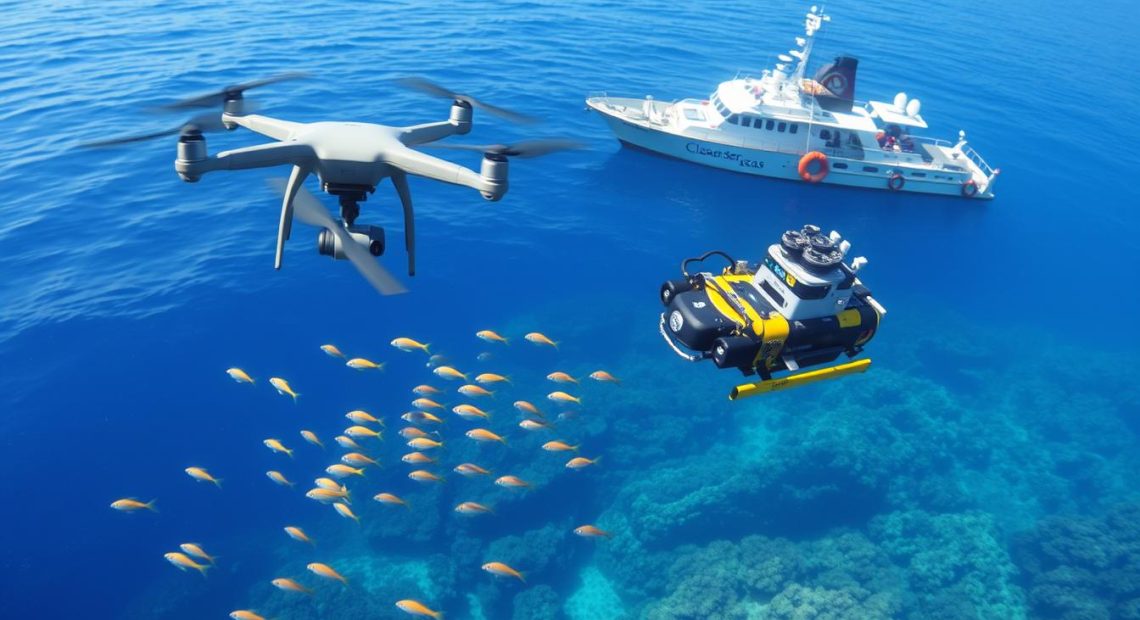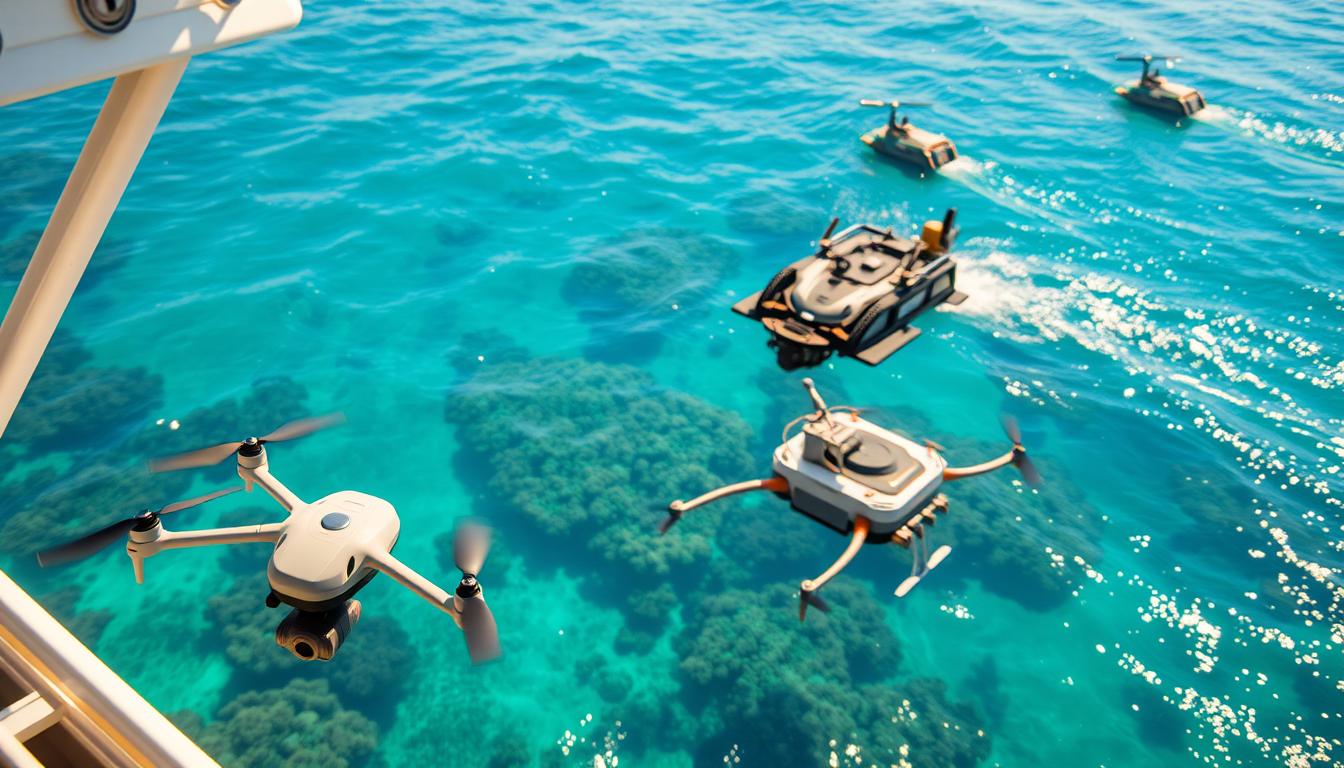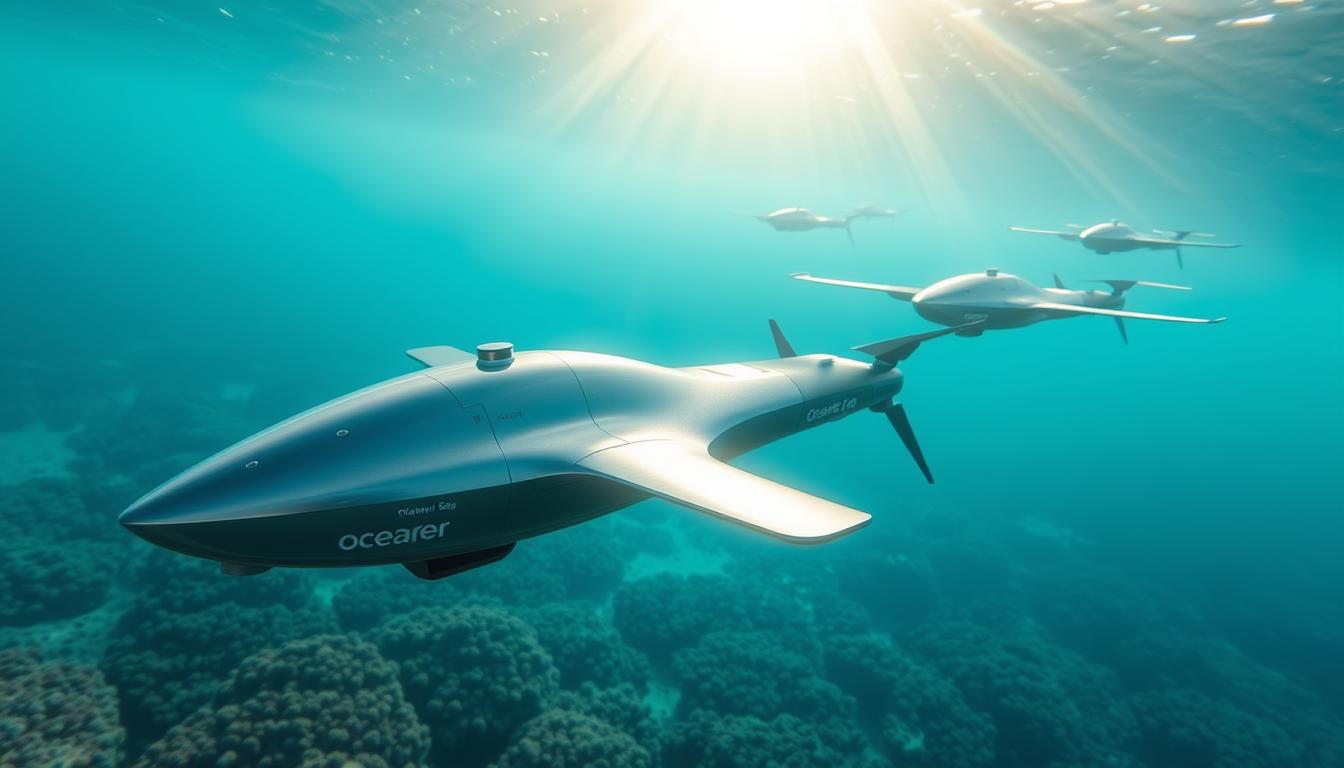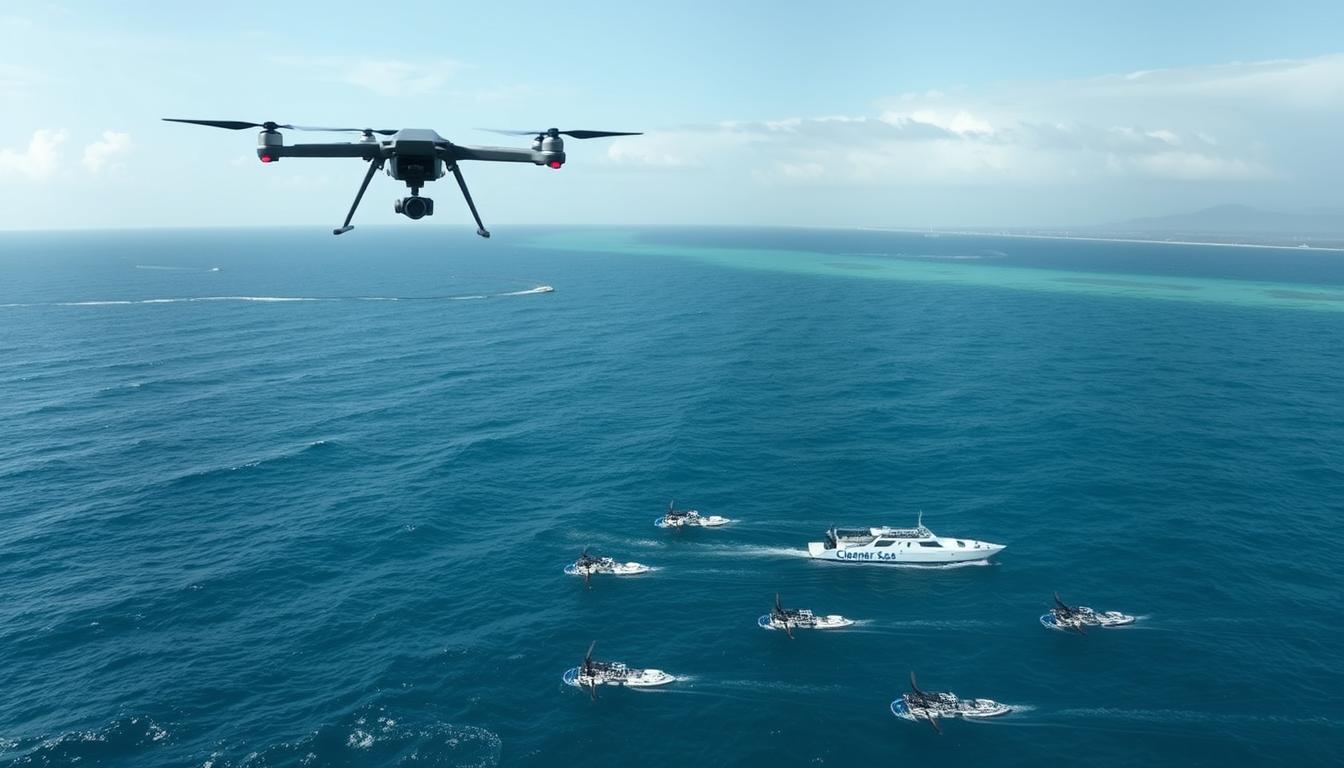Drones & Robotics: The Future of Monitoring Marine Ecosystems

Did you know a ‘dual robot’ drone named MEDUSA can dive 10 metres deep? It checks water quality and tracks climate changes in Arctic seas. This is just the start of how we’ll monitor marine ecosystems in the future.
Drones and Robotics at sea are changing how we protect our oceans. They help us understand marine life and changes in the environment. From flying over coastlines to exploring deep sea, these technologies give us new insights.
Maritime Robotics is more than cool tech; it’s about saving our planet. With over 3,000 articles on drone use, it’s clear this tech is making a big splash. Companies like Marble use drones to watch over coastlines, fighting illegal fishing and human trafficking.
In this article, we’ll see how these new tools are changing science and conservation. They might just save our oceans. The future looks bright with drones and underwater robots watching over us.
Key Takeaways
- MEDUSA, a dual robot drone, can measure water quality up to 10 metres deep
- Maritime robotics are key for tracking climate change in Arctic seas
- Drones help fight illegal fishing and trafficking in coastal areas
- Over 3,000 expert articles show drones’ growing importance
- These technologies are improving how we monitor and protect marine ecosystems
Introduction to Drones & Robotics in Marine Environments
The maritime industry is seeing big changes with the use of Unmanned Aerial Vehicles (UAVs) and Subsea Robotics. These new tools are changing how we study and protect our oceans.
Definition and Overview
UAVs, or drones, are planes that fly without a person on board. In the sea, they help with aerial surveys and mapping. Subsea Robotics, like Remotely Operated Vehicles (ROVs), explore the ocean floor and collect data.
ROVs have been around for decades, starting with the U.S. Navy. They can dive as deep as 120 metres, reaching places we couldn’t before. Today’s ROVs, like the Deep Trekker PHOTON, can record in high-definition 4K for underwater photos and videos.
Importance in Marine Research
These technologies have made a big difference in marine research. UAVs help with wildlife conservation by providing detailed images. Subsea Robotics have changed underwater inspections, making them cheaper and safer.
- ROVs can cut inspection costs by up to 40% in aquaculture
- Fish farms can save 30% or more on maintenance with regular ROV checks
- The energy sector uses ROVs for underwater checks, keeping things safe and in line with rules
As we keep exploring what UAVs and Subsea Robotics can do, their importance in protecting our oceans grows.
The Role of Drones in Marine Ecosystem Monitoring
Oceanic Drone Technology has changed how we monitor our oceans. These drones give us a new view of marine life. They help us understand the ocean and its creatures better.
Aerial Surveys and Mapping
Drones are great at surveying and mapping the sea. They can fly over big areas fast, taking clear pictures of the coast, reefs, and open sea. Scientists use them to track whales, study how creatures behave, and learn about the ocean with great detail.
Data Collection Capabilities
Drones can collect a lot of data. They have special sensors to measure things like:
- Water temperature
- Salinity levels
- Ocean acidity
- Pollution concentrations
Nautical Artificial Intelligence makes these drones even better. It helps them understand and use the data they collect quickly. This means they can spot changes in the ocean fast and alert us to any dangers.
NATO has invested over £60 million in underwater drones. These drones can find and remove mines, making underwater work safer. This shows how important drones are in the sea.
Looking ahead, drones will be key in solving big problems. With more people coming, we need new ways to feed everyone. Drones are helping by checking on fish health and size, even in bad weather. This shows their value in making farming at sea better and more sustainable.
Robotics in Underwater Exploration
Underwater robotics has changed how we explore the sea. It lets us dive to depths humans can’t reach. These robots work in harsh conditions, handling huge pressure and dark environments.
Autonomous Underwater Vehicles (AUVs)
AUVs are underwater robots that go on their own. They carry tools like temperature probes and depth recorders. AUVs make detailed maps of the sea floor and 3D images of underwater objects.
ROVs: Remote Operated Vehicles
ROVs are robots connected to the surface by a cable. They are key in marine research, oil & gas, and watching the environment. ROVs can dive as deep as 6,000 meters, facing water pressure of 596 atmospheres.
Marine Automation Systems have made ROVs better. For example, the lag time for controlling ROV Deep Discoverer from shore is now just 1.25 seconds. These systems also let ROVs measure extreme temperatures near hydrothermal vents, up to 400°C.
- ROVs can do underwater checks, maintenance, and repairs
- They are vital in search and recovery missions
- Advanced ROVs can dive over 10,000 meters
The MEDUSA ‘dual robot’ drone shows how far underwater robotics has come. It can fly, land on water, and send an underwater pod down to ten metres. This shows the big steps forward in sea exploration technology.
Enhancing Marine Biodiversity Studies with Technology
The field of marine biodiversity research is changing fast, thanks to Maritime Robotics. These advanced technologies give us new insights into our oceans. They help scientists track fish and check coral reef health with great detail.
Monitoring Fish Populations
Offshore Robotic Platforms are changing how we watch fish populations. Unmanned aerial vehicles (UAVs) can fly far and fast. They take pictures in wavelengths we can’t see.
This tech lets researchers:
- Spot illegal fishing more easily
- Follow whale migrations more accurately
- Help manage fisheries for better conservation
For example, WhaleSafe’s system makes analysing whale data much better. It uses real-time acoustic monitoring.
Assessing Coral Reef Health
Maritime Robotics are key in saving coral reefs. AI systems check reef health and spot problems early. Underwater drones give us data from hard-to-reach places.
These tools are essential in fighting threats to marine life. Climate change, overfishing, and pollution harm our oceans. For example, 80% of marine litter is plastic, with 14 million tons entering the ocean yearly.
Innovative solutions like WasteShark drones help clean up. They can collect up to 500 kilograms of marine litter daily. This helps protect our oceans.
Case Studies: Successful Applications in the UK
Drones and robotics have changed marine research and conservation in the UK. They have brought new technology that helps us understand and protect marine life better.
Real-life Examples of Drone Use
The Auxdron LFG drone, made by General Drones, is a great example. It can start a rescue in just six seconds, even in bad weather. Its design meets strict standards for materials and shape.
Another success is the work between drone makers and Protolabs. They use 3D printing to make drone parts faster. This has cut down the time it takes to make and deliver parts, thanks to advanced printing methods.
Lessons Learned from Implementations
Using drones and robotics at sea has taught us a lot:
- Cost savings: Offshore wind farms could cut costs by up to 9.5% by 2030.
- Improved safety: In 2019, most incidents in offshore wind farms happened on turbines or vessels. This shows the need for robots.
- More availability: Robots could increase the availability of fixed wind farms by up to 1.07%.
These examples show how drones and marine robots can change how we monitor and manage marine life. As we keep innovating, the future of marine monitoring looks bright.
Benefits of Using Drones and Robotics
Maritime Robotics and Nautical Artificial Intelligence have changed marine research and monitoring. They bring big advantages over old methods. These tools are key for saving our oceans today.
Cost Efficiency and Time Savings
Drones and robotics save a lot of money and time. The Norwegian Rescue Society started using drones in 2014. These systems can quickly cover big areas and reach hard-to-get places.
The RNLI is looking at the SplashDrone 4. It can handle winds up to 45 miles per hour. This shows how well these tools work in tough weather.

Enhanced Data Accuracy
Maritime Robotics with advanced sensors give precise data. Sea Machines’ tech has spotted millions of targets. This makes it one of the biggest marine data sets out there.
This accuracy is vital for checking fish numbers and coral health. It helps us understand our oceans better.
- Autonomous systems offer reduced operational costs and longer missions
- UAVs are significantly more cost-effective than traditional rescue alternatives
- Nautical Artificial Intelligence enhances situational awareness through multiple data sources
The benefits of drones and robotics in the sea are obvious. As they get better, we’ll see more savings, faster work, and better data. This will keep changing how we study and protect our oceans.
Challenges Faced in Marine Robotics
The world of Subsea Robotics is growing, but it’s not without its problems. Using Offshore Robotic Platforms offers great chances but also big challenges.
Environmental Concerns
Subsea Robotics must deal with tough marine settings. They face harsh weather and strong electromagnetic interference. This can make them less effective.
For example, Boaty McBoatface, a top underwater robot, works at 6,000 metres. There, the pressure is 600 times more than at sea level.
Regulatory Issues
Offshore Robotic Platforms must follow strict rules. From 2014 to 2019, there were about 2,664 marine incidents each year. Drones have shown they can help in rescues, but they must follow maritime laws and data privacy rules.
- Complex maritime environments pose technical challenges
- Harsh weather conditions can restrict usage
- Strong electromagnetic interference affects performance
- International maritime laws and data privacy regulations must be adhered to
Even with these obstacles, the future of Subsea Robotics and Offshore Robotic Platforms looks bright. We must keep innovating and solve these problems for marine robotics to grow.
Future Trends in Drones & Robotics at Sea
The maritime industry is on the verge of a big change. Oceanic drone technology and marine automation systems will change how we watch and explore our seas. Let’s look at the exciting new things coming and what we can expect in the next ten years.
Innovations on the Horizon
Shape-shifting drones are becoming real. The ProteusDrone project is working on drones that can change shape for different underwater places. This could change how we explore and gather data from the sea.

Swarm robotics is also very promising. These groups of robots can cover huge areas of the ocean. They can collect data on sea life, pollution, and climate change better than ever before.
Predictions for the Next Decade
By 2030, the Sea Drones Systems market is expected to grow to €18.9 billion. This growth is at a rate of 15.5% each year. Unmanned Underwater Vehicles (UUVs) will make up 70% of the market.
- Civilian uses will likely grow to €15.9 billion, making up 84% of the market.
- Military use is expected to increase by 172.7%, from €1.1 billion in 2022 to €3.0 billion by 2030.
- Autonomous Unmanned Vehicles (AUVs) could reach €7.1 billion in value by 2030.
These new developments in oceanic drone technology and marine automation systems will change many areas. Deep-sea exploration, climate research, and marine conservation will all see big changes. As leaders in this field, we’re excited to be part of this technological journey, shaping the future of the sea.
Collaborations Between Technology and Marine Biology
The mix of Maritime Robotics and marine biology is changing ocean research. Tech companies, universities, and marine institutes are working together. They are making big strides in understanding marine life.
These partnerships are shaping the future of exploring and protecting our oceans.
Research Partnerships
The NTNU-VISTA Centre for autonomous operations subsea is a great example. It got a NOK 25 million grant from the Norwegian Academy of Science and Letters and Equinor. This centre will push the limits of Maritime Robotics.
The team in Trondheim is already leading in snake robots and marine robotics. They are working on new ways to map and monitor the ocean.
Oceans cover over 70% of our planet, but much is unknown. This centre aims to change that.
Educational Initiatives
Programmes are teaching the next marine scientists about robotics and Nautical Artificial Intelligence. The VISTA programme has given out over NOK 300 million. It supports young researchers and VISTA professorships.
This investment in education prepares a skilled team for marine challenges. It’s not just about tech; it’s about protecting our oceans.
Maritime Robotics is used in many areas, like coral reef monitoring and deep-sea mining. As we keep innovating, technology and marine biology will lead to more discoveries and better ocean care.
Environmental Impact and Conservation Efforts
Drones & robotics at sea are key in protecting marine habitats and studying climate change. They bring new ways to monitor the environment and help conservation.
Safeguarding Marine Ecosystems
Autonomous surface vessels use advanced sensors to collect data on ocean conditions. This data helps scientists understand marine health and plan conservation efforts.

Small ocean gliders, powered by waves and sun, travel long distances to gather data. They give insights into plankton and weather, aiding in biodiversity and climate studies.
Climate Change Research
Drones & robotics at sea are vital for climate studies. They track sea level rise, ocean acidification, and changes in marine life. This data is key for fighting global warming’s effects on oceans.
- Aerial drones assess coastal erosion and deforestation
- Underwater robots study coral reef health
- Autonomous surface vessels track oil spills and pollution
These technologies are becoming more important in environmental research. The commercial drones market is expected to hit £6.8 billion by 2025, with environmental monitoring leading the way.
“Drones and robotics are becoming indispensable tools in our fight against climate change and efforts to preserve marine biodiversity.”
As we face more environmental challenges, drones & robotics at sea offer hope. They help us develop better conservation strategies and understand our changing oceans.
The Importance of Policy and Regulation
As Unmanned Aerial Vehicles and Remotely Operated Underwater Vehicles become more common, strong policies and rules are essential. The UK is working to find a balance between innovation, safety, and protecting the environment.
Current Policies Affecting Drone Use
The UK’s drone rules are seen as strict but lacking in clear standards. This has led to businesses moving to countries with more flexible rules. The absence of certification schemes hinders safe use and raises costs.
Commercial drone use is not allowed in the UK, causing businesses to leave. The Department for Business, Energy & Industrial Strategy sees drones as vital for future growth. Yet, the UK’s rules don’t match international standards.
Future Directions for Legislation
The Regulatory Horizons Council proposes simpler rules backed by strong safety and quality standards. This could lower costs and open up new opportunities. A unified set of rules across all areas aims to save time and money.
- Introducing mandatory transponder zones for drone operations
- Plans for mandatory electronic conspicuity by 2025
- Developing uncrewed traffic management systems for airspace management
The growth of autonomy and cross-domain operations demands quick changes in rules. Being involved in setting ‘Safety and Quality’ standards early is key. This helps avoid falling behind in technology, like in Remotely Operated Underwater Vehicles and marine robotics.
Conclusion: The Future of Marine Ecosystem Monitoring
Drones and robotics at sea are leading the way in marine ecosystem monitoring. They are changing how we understand and manage our oceans. This is thanks to their integration with advanced marine automation systems.
The underwater robotics market is growing fast, reaching USD $4.49 billion. It’s expected to grow by 14.5% each year from 2023 to 2030. This is because AUVs and ROVs are becoming more popular in marine research and industry.
AI is making a big difference in marine research. It helps process data quickly and make decisions fast. AI can even identify marine species from videos, track biodiversity, and monitor populations fast and accurately.
Looking ahead, drones and robotics will be key in solving big ocean problems. They will help us tackle climate change, protect biodiversity, and reduce pollution. With marine automation systems, we can better protect our oceans and the life they support.
FAQ
What are the main types of robotics used in marine ecosystem monitoring?
How do drones contribute to marine ecosystem monitoring?
What are the benefits of using drones and robotics in marine research?
How are robotics enriching marine biodiversity studies?
What challenges are faced in implementing marine robotics?
How are drones and robotics contributing to climate change research?
What future trends can we expect in marine robotics?
How are collaborations between technology and marine biology advancing the field?
What role do policy and regulation play in marine robotics?
How are Autonomous Surface Vessels (ASVs) used in marine research?
Resources
- https://www.imperial.ac.uk/news/237274/shape-shifting-drone-flies-dives-seek-aquatic/ – Shape-shifting drone flies and dives to seek aquatic environmental clues | Imperial News | Imperial College London
- https://dronelife.com/2024/05/06/drones-over-water-marbles-quest-to-transform-coastal-monitoring-on-the-drone-radio-show/ – Drones Over Water: Marble’s Quest To Transform Coastal Monitoring on the Drone Radio Show!
- https://www.deeptrekker.com/news/underwater-drone-101 – Underwater ROV 101: The Ultimate Guide
- https://core.ac.uk/download/pdf/477681499.pdf – Maritime Robotics and Autonomous Systems Operations: Exploring Pathways for Overcoming International Techno-Regulatory Data Barriers
- https://interestingengineering.com/innovation/nato-underwater-mine-drone – NATO to get new advanced robot drones to hunt underwater mines
- https://www.azolifesciences.com/article/Under-the-Sea3b-Importance-of-Underwater-Robots-and-Drones-in-Sea-Farming.aspx – Under the Sea: Importance of Underwater Robots and Drones in Sea Farming
- https://oceanexplorer.noaa.gov/explainers/technology.html – How Robots Are Uncovering the Mysteries of the Deep
- https://thinkrobotics.com/blogs/learn/underwater-robotics-revolutionizing-marine-exploration-and-industry?srsltid=AfmBOoqsyj3bniVuj91Zbx-3Bhj6olHS7RyjgjWTJE5zGgp5mnOW9BQa – Underwater Robotics: Revolutionizing Marine Exploration and Industry
- https://builtin.com/articles/underwater-robotics – Underwater Robotics: How It Works and Examples | Built In
- https://skyx.com/blog/when-sky-meets-sea-drone-technology-for-protecting-marine-life-and-ecosystems/ – Drone Technology for Protecting Marine Life and Ecosystems
- https://www.youthstem2030.org/youth-stem-matters/read/the-role-of-emerging-technologies-in-ocean-conservation – The Role Of Emerging Technologies In Ocean Conservation — Youth STEM 2030
- https://www.nature.com/articles/s41467-023-42882-3 – Bioinspired soft robots for deep-sea exploration – Nature Communications
- https://www.protolabs.com/en-gb/resources/case-studies/general-drones/ – General Drones | Case Studies | Protolabs
- https://cms.ore.catapult.org.uk/wp-content/uploads/2021/09/OWIH01_9501-OWIH-Deep-Dive-Robotics-compressed-2.pdf – PDF
- https://www.azorobotics.com/Article.aspx?ArticleID=569 – Supporting Sea Rescue With Drones and UAVs
- https://sea-machines.com/autonomous-systems-vs-unmanned-vessels-and-drones/ – Autonomous Systems Vs. Unmanned Vessels and Drones – Sea Machines Robotics
- https://www.mdpi.com/2077-1312/11/11/2056 – Applications, Evolutions, and Challenges of Drones in Maritime Transport
- https://www.bbc.co.uk/news/business-48620704 – The super-tough drones and robots going where we can’t
- https://www.strategyand.pwc.com/it/en/assets/pdf/sea-drones-report.pdf – PDF
- https://www.naval-technology.com/sponsored/drones-of-the-sea-the-rise-of-unmanned-surface-vehicles/ – Drones of the sea: the rise of unmanned surface vehicles
- https://marine-digital.com/article_robotics_in_maritime_industry – How robotics is changing the maritime industry and what kind of robots are being used in shipping?
- https://sciencebusiness.net/network-updates/ntnu-launches-underwater-drone-and-robot-centre-reduce-environmental-footprint – NTNU launches underwater drone and robot centre to reduce environmental footprint of industry at sea
- https://onwamarine.com/advancements-in-marine-technology-ocean-exploration/ – Advancements In Marine Technology Leading Ocean Exploration
- https://etech.iec.ch/node/249 – Protecting the environment with drones and robots
- https://www.therobotreport.com/how-uncrewed-vehicles-are-assisting-in-combating-climate-change/ – How uncrewed vehicles are assisting in combating climate change – The Robot Report
- https://www.dronedeliverygroup.org/images/DDG/PAPERS/A_National_Strategy_for_Drones_Across_Land_Sea_and_Ai.pdf – Microsoft Word – A National Strategy for Drones Across Land, Sea and Air.docx
- https://www.gov.uk/government/publications/countering-drone-threats-to-shipping/countering-drone-threats-to-shipping – Countering drone threats to shipping
- https://assets.publishing.service.gov.uk/media/617be4f88fa8f52985dd76c1/rhc-drones-report.pdf – The Regulation of Drones: an exploratory study
- https://howtorobot.com/expert-insight/underwater-robots-navigating-depths-maritime-industry – Underwater robots: Navigating the depths of the maritime industry
- https://yaquts.com/blog/ai-and-robotics-revolutionizing-ocean-exploration/ – How AI and Robotics Are Revolutionizing Ocean Exploration – YAQUT INVESTMENT















